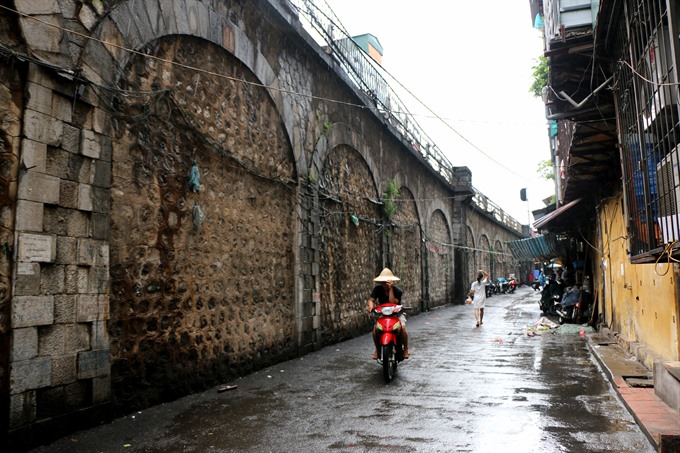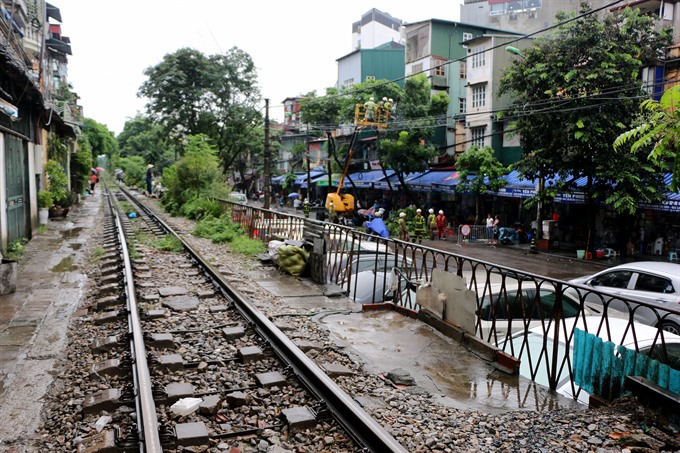 Features
Features

The Hà Nội authority has recently decided to give Gầm Cầu Street in Hà Nội’s Old Quarter a makeover by reconverting more than 100 vaults into galleries, exhibition space, handicrafts shops and cafés; something that could be the Viaduc des Arts of Việt Nam.
 |
| Tourism boost: Hà Nội authorities have recently decided to give Gầm Cầu and Phùng Hưng Street a makeover by converting more than 100 vaults into galleries, exhibition spaces, handicraft shops and cafés; something that could be the Viaduc des Arts of Việt Nam. —VNS Photos Đoàn Tùng |
by Hồng Vân
Gầm Cầu Street in Hà Nội’s Old Quarter is only 4m wide, yet it is teeming with people, merchants, vehicles and shops offering a wide range of products.
The Hà Nội authority has recently decided to give this neighbourhood a makeover by reconverting more than 100 vaults into galleries, exhibition space, handicrafts shops and cafés; something that could be the Viaduc des Arts of Việt Nam.
The railroad viaduct, which starts from Phùng Hưng-Trần Phú crossroads to the Long Biên Train Station and passes through the Phùng Hưng and Gầm Cầu streets, is 1.2km long, with a slope steepness of zero to six metres, under which there are a total of 131 vaults. Among them, only four vaults are open, and the remaining are sealed with cement.
The vaults, built in 1900 and finished in 1902, are 3.5m to 4.5m high and covers about 16sq.m area each.
The viaduct is part of the historic Long Biên Bridge, which carries the rail connecting Hà Nội with the port city of Hải Phòng.
The bridge, more than 100 years old, spans three centuries and is considered an important and central part of Hà Nội’s development, as well as history. The steel structure was there when the French troops left Hà Nội, and even when the city welcomed the Vietnamese soldiers to take over it in 1954.
 |
| Pretty passage: One of the four vaults open for walkways in Hàng Hương Street. Each vault covers about 16sq.m. |
In the 1960s, the bridge was an arterial track to transport passengers and commodities, the symbol of Hà Nội’s resistance to relentless US bombing.
In 1971, a severe flood occurred in the Red River region; the areas in Phúc Xá, Phúc Tân and Chương Dương were inundated, compelling residents to evacuate the city’s centre. The vaults under the viaduct, at that time, became a shelter for the people in need.
In the 1970s, diesel locomotives replaced the old steam locomotives, which helped increase the load capacity significantly. In addition to this, the vaults under the viaduct also became a hub for beggars and drug addicts.
Therefore, in the period between 1978 and 1983, up to 127 vaults were sealed with cement to strengthen the viaduct and keep out anti-social elements from the neighbourhood. Only four were kept open to create walkways for citizens.
Until now, locals were using the space in front of the vaults as a parking lot or to display their wares, such as green tea and other comestibles, for sale.
In 2003, two architects Trần Ngọc Hiếu and Lê Hồng Minh won the third prize for their Gầm Cầu Street Awakens project that reconverted the vaults into art spaces, souvenir shops and galleries for an architecture contest that aimed to seek charming corners in Hà Nội. The contest was held by the Việt Nam Urban Planning and Development Association.
The city authority has decided that all the vaults should be reopened, as part of a project to expand the cultural space for the capital’s residents.
In a meeting with voters of Hoàn Kiếm District in June, chairman of the city’s People’s Committee Nguyễn Đức Chung said that the district’s People’s Committee had invited experts to plan the project.
 |
| Important route: The viaduct is part of the historic Long Biên Bridge, which carries trains connecting Hà Nội with the port city of Hải Phòng. |
Four vaults had been opened to create walkways and the remaining 127 would be converted into public spaces for art and cultural activities, Chung said.
“Reopening the vaults will not only create more cultural spaces for the public and boost the city’s tourism, but also facilitate traffic in the inner city, especially on the narrow Gầm Cầu street, whose surface has been damaged,” Chung said.
“Converting a forgotten structure into a cultural space is an appreciable idea,” said architect Trần Huy Ánh.
“Though the viaduct was originally designed with empty vaults, it has degraded over more than 100 years of operation. What is more, the load capacity of the train has increased over time; therefore, careful examination of the bearing capacity is necessary before implementing the project,” Ánh said.
Architect Lê Việt Sơn agreed with the initiative: “Reopening the vaults has a significant meaning. It is necessary and should be done as soon as possible. Along with the Old Quarter, Red River and the Hà Nội Opera House, the Long Biên Bridge has been an integral part of Hà Nội. The viaduct with vaults is an integral part of the bridge. It is one of the components of the bridge. It is worth noting that the railway also holds memories and reflects the urban life.”
“It is crucial that we conduct a careful survey, as this structure is more than 100 years old. It is important to have an evaluation board to work out the most optimum solution,” Sơn added.
The initiative of converting the vaults into an art space has been nominated for the Bùi Xuân Phái Award. The annual award was launched in 2008 by the Vietnam News Agency’s Thể Thao Văn Hóa (Sports and Culture). It is named after renowned painter Bùi Xuân Phái (1920-1988) in honour of his career and aims to continue spreading his love for Hà Nội.
The Bùi Xuân Phái Award aims to honour the contributions of individuals and organisations to society, culture and the arts in Hà Nội. VNS
 |
| City streets: The vaults were sealed with cement to strengthen the viaduct and keep out anti-social elements from the neighbourhood in the 1980s. |